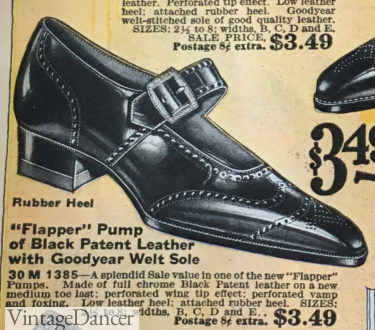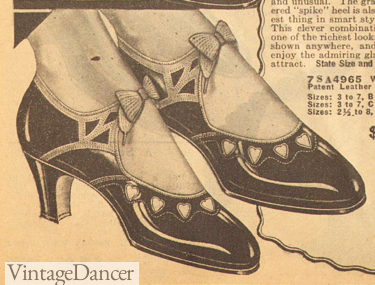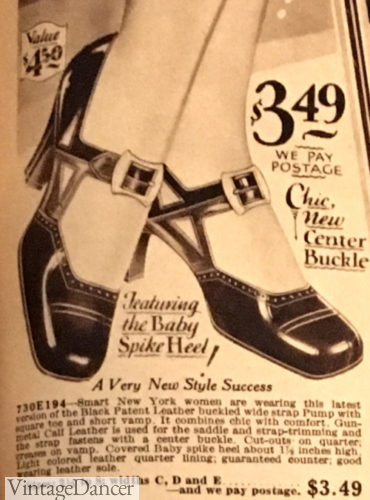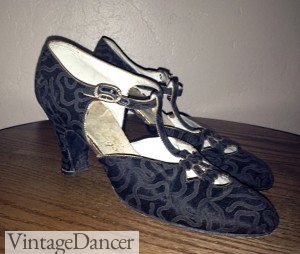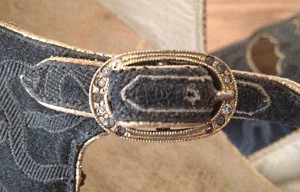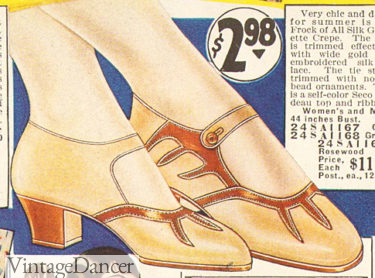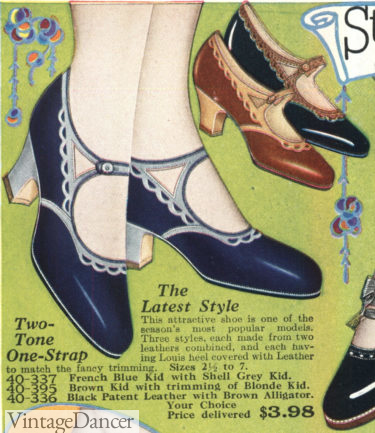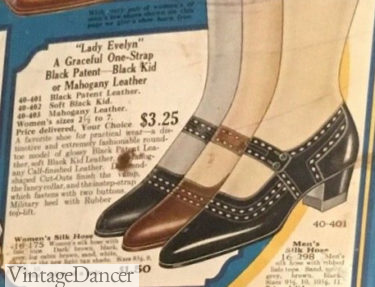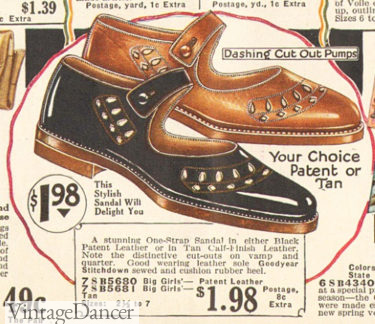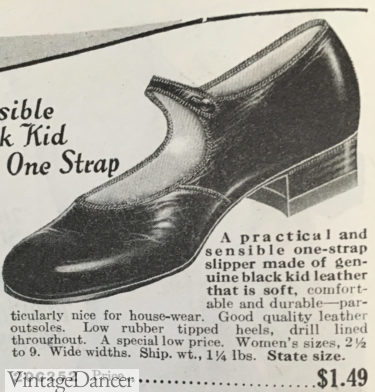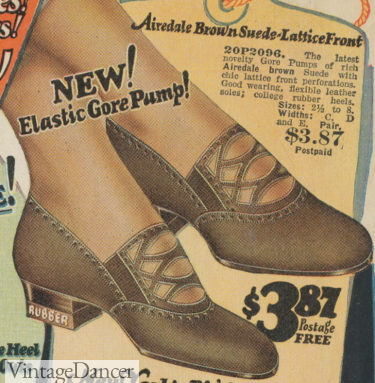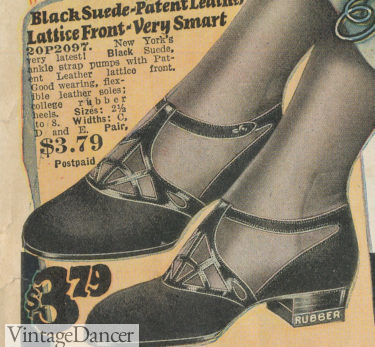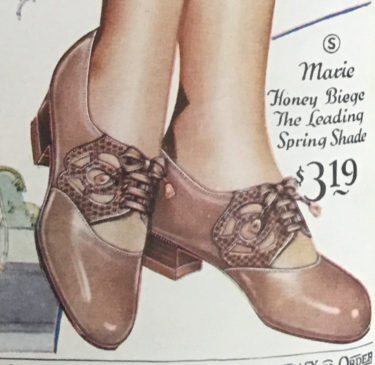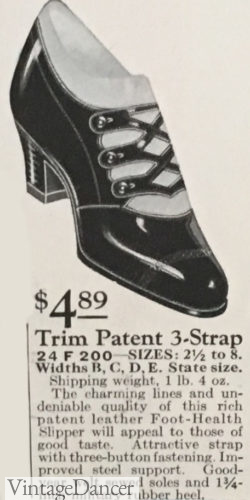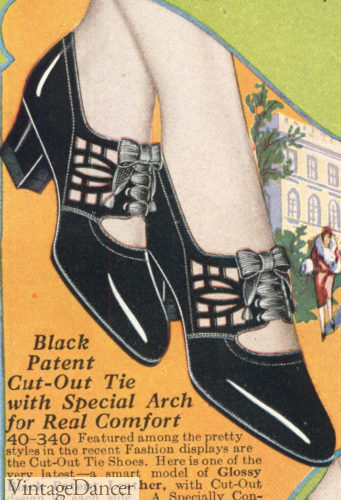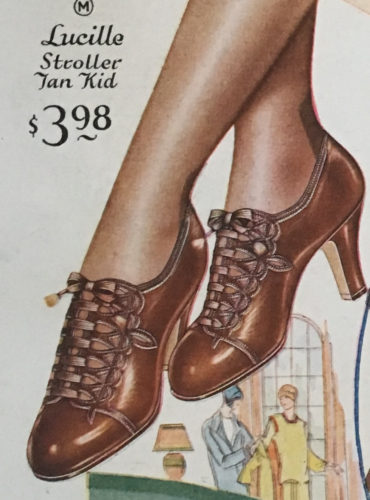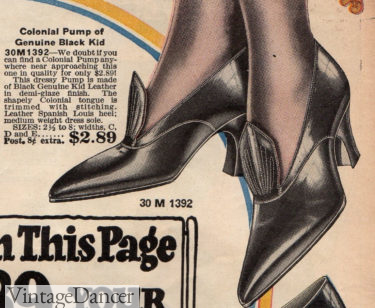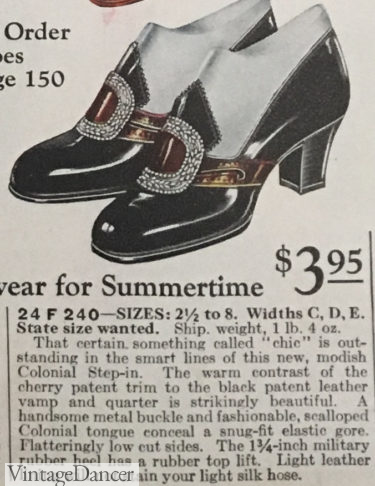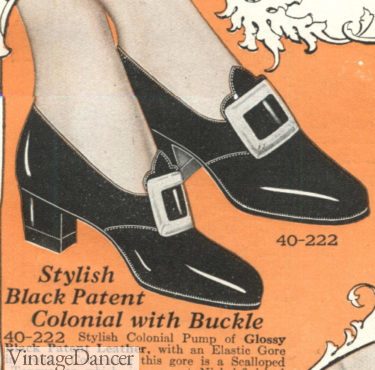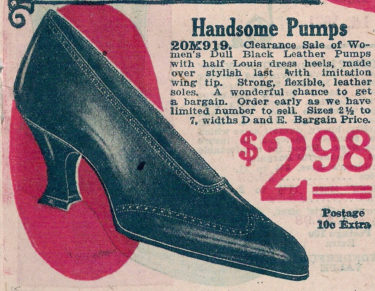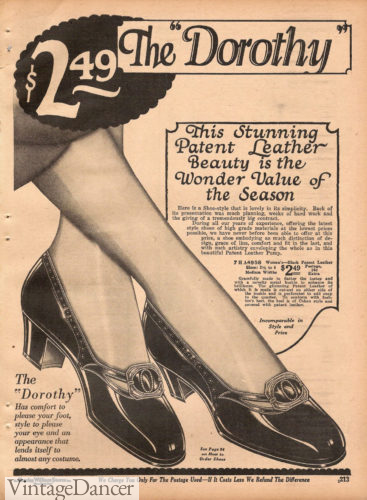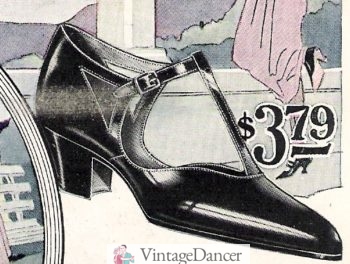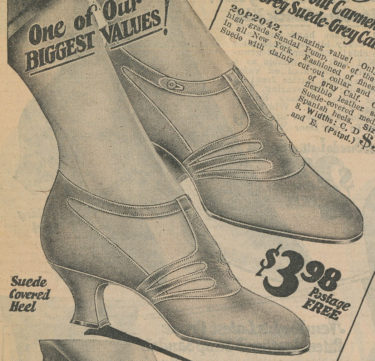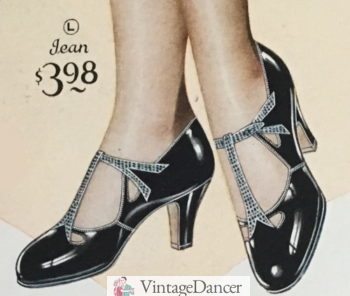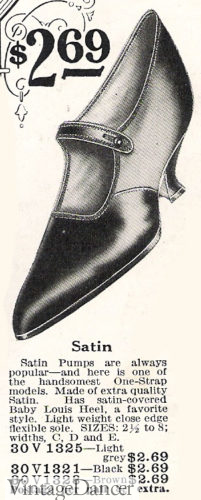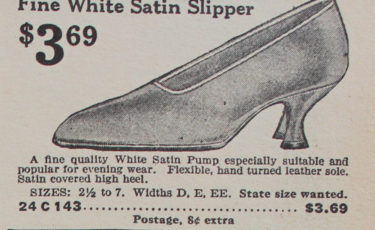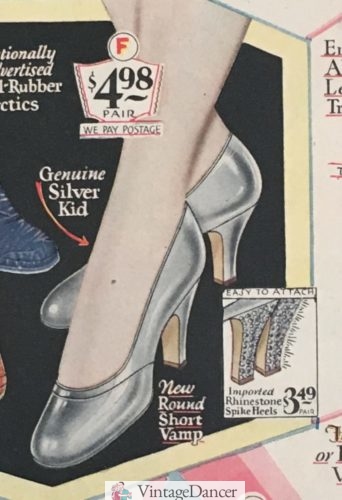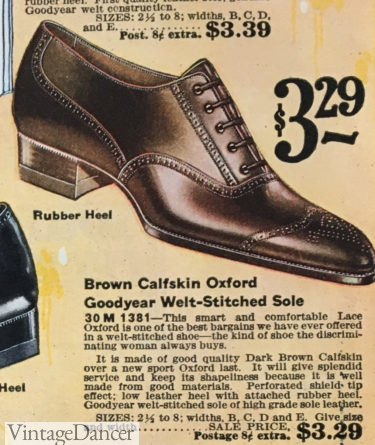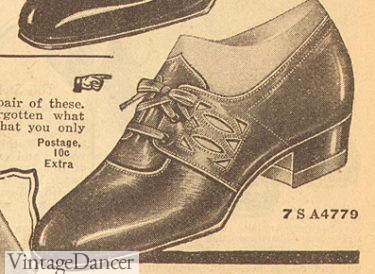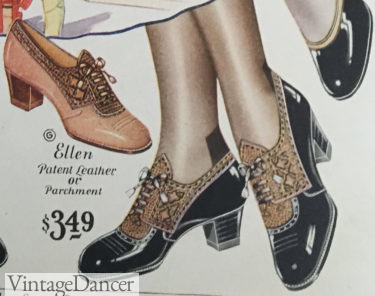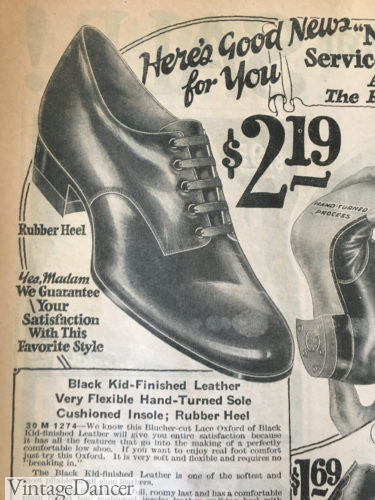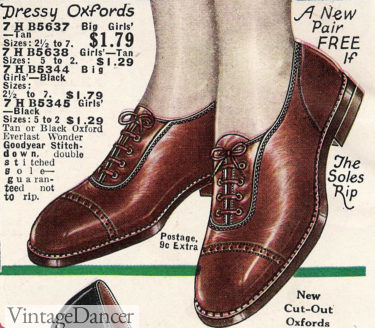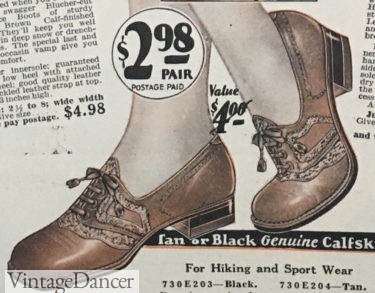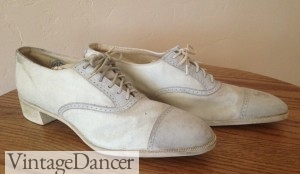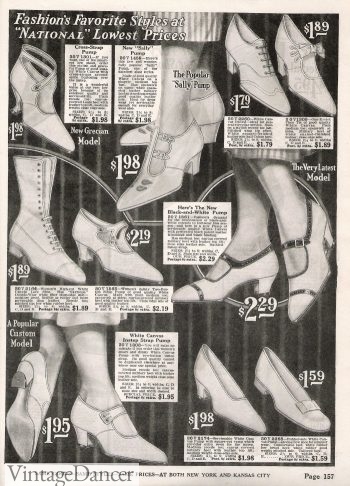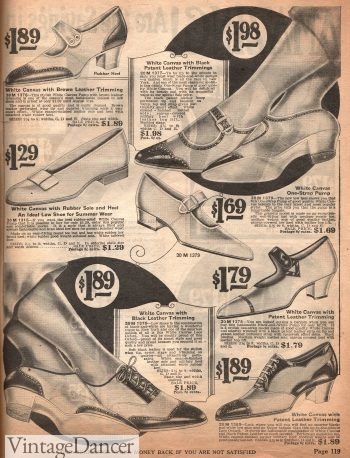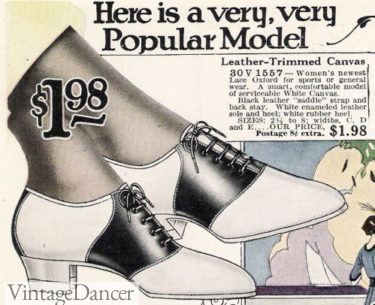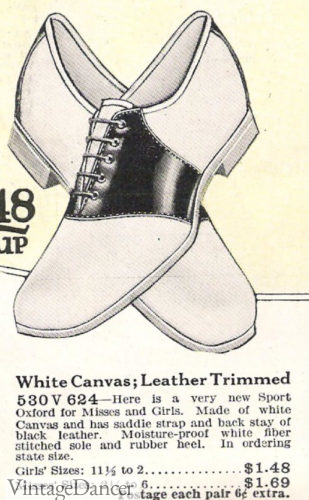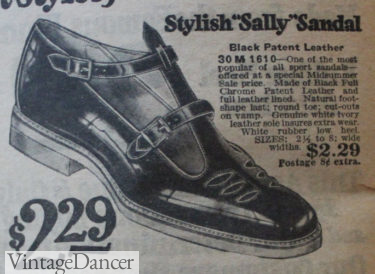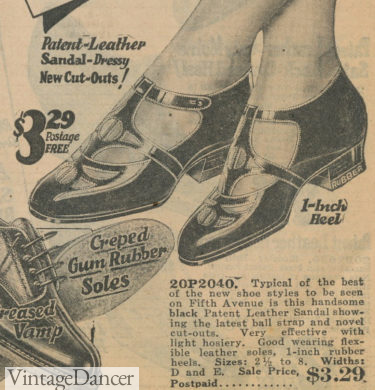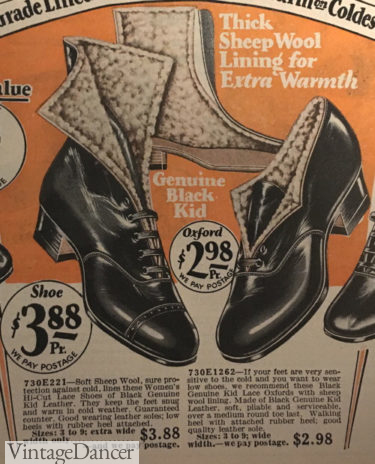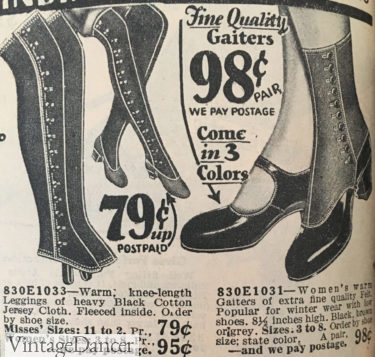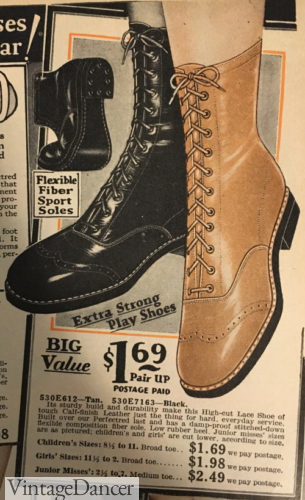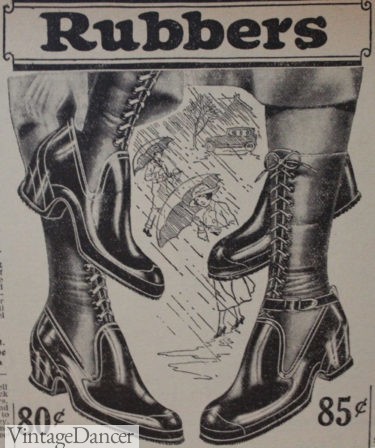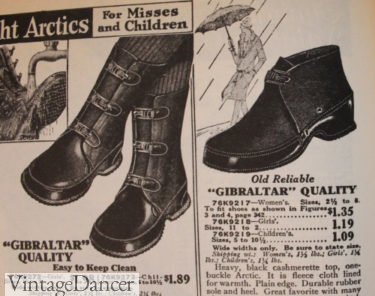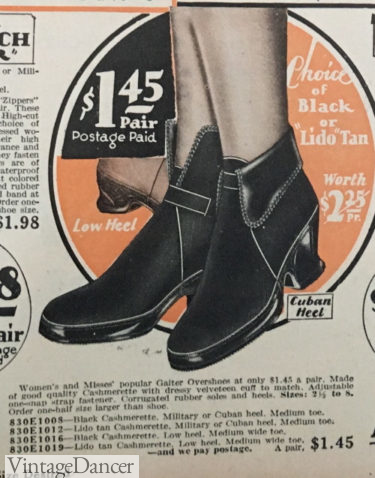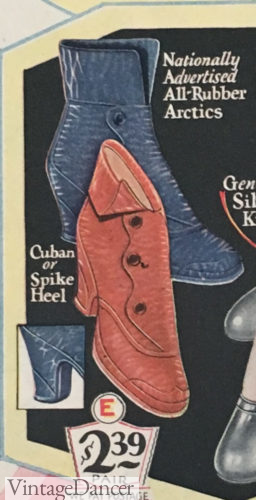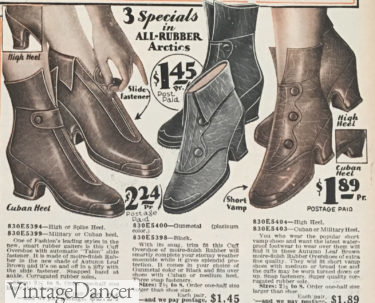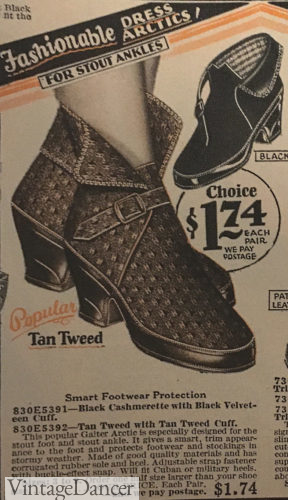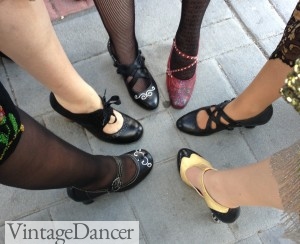The most remarkable thing about women’s shoe history in the 1920s was that they were visible! Long garments of the decades before covered up ladies’ shoes, putting their style and decoration in the family of pretty lingerie — a secret only the wearer would know about. All that changed when hemlines rose above the ankle and kept on rising to the knee. Now shoes were seen and admired and matched to not only the style of the garment, but to the season as well. This caused clothing designers to make new clothes with shoes in mind. They often became shoe designers as well as dressmakers.
Shop 1920s style shoes here.
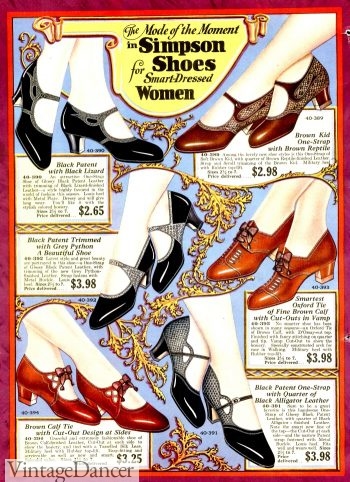
1928 Catalog – Oxfords and low heel Mary Jane Walking Shoes
The pump with one or several straps and a modest 2-inch heel was the most popular shoe of the roaring twenties. Basic slip-on pumps, 18th century inspired colonial shoes, walking Oxfords, and boots made up the other shoe styles. For summer days and sporty activities, there were canvas flats, two-tone saddle shoes, and the first canvas sneaker. Young flappers made galoshes the fashionable boot to wear in winter.
The demand for new shoes in new styles every season made custom-fit shoe ordering a thing of the past. Now shoes were made in standard sizes, ready to buy from your local clothing store or mail order catalog. The shoe industry exploded in the 1920s.
Roaring 20s Shoe Details
Shoe heels for daywear were sturdy “Louis” heels, also called tango, curved, Spanish or vintage heels. They were about 2 inches high. The curved heel went out of fashion in the mid-20s, being replaced by the sturdier military or Cuban heel.
The 1-inch stocky Cuban heel was common on house shoes and low walking shoes. The 1 3/4 inch “Military heels” were the perfect height for sporty oxfords and some daytime heels. Rubber heels and soles were added to walking shoes for comfort and stability in the mid-’20s, otherwise leather soles remained the standard.
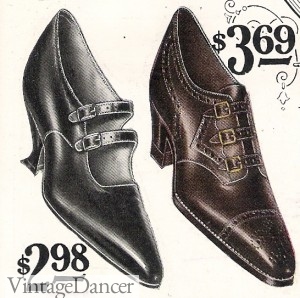
1922 shoes with (L) Louis Heel and (R) Military Heel
Toes were very pointed in the early years and followed the Edwardian shoe trend, before rounding out in the mid-twenties into the almond toe. They became almost square in the late 1920s.
- 1922 pointed toe shoes
- 1926 almond toe shoes
- 1929 square toe
Materials – Most shoes were made of leather. Calfskin, kid, suede, lizard, alligator, and goat were the most popular. Both matte finish and shiny patent leather was equally as popular for the daytime. Meanwhile, evening shoes required heels that sparkled with a high sheen. Colors for day shoes tended to be shades of black, brown, grey, and beige (called blonde). Two types of contrasting leather could be combined on the shoe body and straps to create unique swirl patterns, color blocking, or texture blocking.
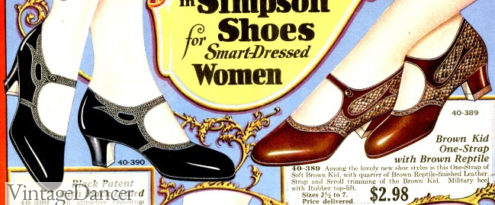
1928 lizard skin on black patent leather, and reptile skin on brown kid leather
Sport shoes and summer heels were made of sturdy gabardine or canvas cloth. Leather shoes could be inset with panels of cloth for ventilation. This resulted in two-tone shoes of brown & white or brown & tan, with the occasional black and ivory combination. The more trendy women at the end of the decade chose bright colored shoes in bold red, orange, blue, white, and any combination of these together. Red bodies with blue heels, sometimes striped, gave a decidedly Art Deco look.
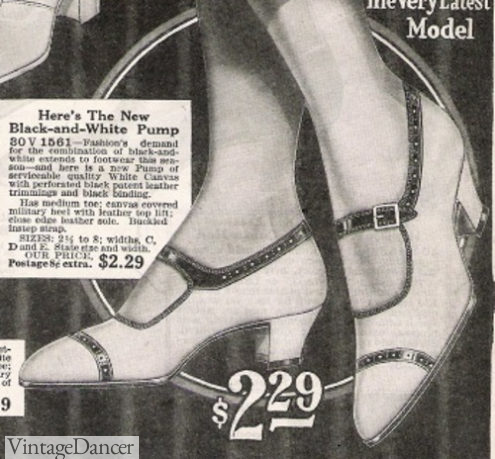
1922 white canvas with black patent trim
Indoor shoes were pretty satin, grosgrain, brocade, velvet, or lambskin materials. These could be worn in the evenings too, for dinner and dancing.
Buckles and buttons (Fasenettas) were covered in precious stone and metal sequins over diamante onyx (shiny black), bronze, or pearl. Button covers made decorative plain shoes affordable to the poor. As the decade progressed, straps became thinner and covered in precious stones or metal sequins and/or shaped into geometric designs. Cutouts on the sides, toes and straps added even more skin exposure and more places for geometric “Art Deco” shapes to form.
1920s Women’s Shoe Styles
“Strap pump” shoes were the trendiest of the ’20s shoes. Single strap shoes across the vamp were called “strap shoes” in the ’20s. There were also straps that crisscrossed in an X pattern or went straight across with 2-4 thin straps. Small cutouts on the sides that connected to the strap across the vamp were also very common. All straps on dressy heels were thin and getting thinner as the decade progressed.
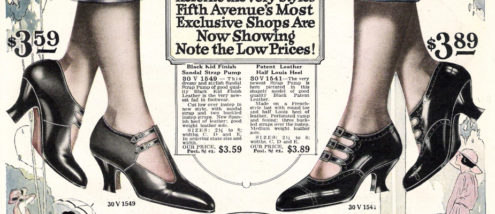
1922 double T-strap and triple Mary Jane straps
Some straps did not buckle but were tied with a silk ribbon bow. Ribbon looped through eyelets on either side and tied at the center. Ribbon laces were especially common on walking oxfords.
Mary Jane Shoes
The pump with a single strap across the vamp, called a Mary Jane today, was the most popular shoe of the roaring twenties. It came in fancy “flapper” models as well as practical low heel comfort shoes and summer sandals. Maids and servants were required to wear simple Many Jane shoes with soft soles that didn’t make noise while walking through the house.
The Mary Jane shoe is the easiest shoe to find today because it never went out of style. What has been lost are the very decorative straps and buckles.
- 1926 blonde leather Mary Janes
- 1928 classic Mary Jane shoes
- 1928 patent leather with reptile straps
- 1925 low heel Mary Jane comfort shoes
- 1926 Mary Jane “Sandals”
- 1928 simple Mary Jane soft shoes
Lattice Pumps
Lattice strap pumps were made of a wide band across the vamp with cutouts all over, creating a latticed or stained glass window effect. Many were lace-up style – somewhere between a low heel oxford and a slip-on pump.
- 1924 brown suede lattice pump
- 1924 lattice T-strap shoes
- 1928 lattice low heel shoes
- 1927 lattice straps with buttons
- 1928 patent leather lattice pump
- 1928 lattice lace-up shoes
Colonial Pumps
The 1920s looked back on the 18th century by reviving theater plays, masquerade costumes, Robe de Style dresses, and shoes. The Colonial shoe was a slip-on low heel pump with a fancy tongue, buckle, or shoe clip on the center vamp. They were practical for daywear and fancy enough for evenings when made of silk or satin.
- 1922 colonial tongue pumps
- 1927 colonial two-tone buckle pump
- 1928 colonial buckle pump
Step-in Pumps
The Colonial pump inspired the basic slip-on pump. Later called a D’Orsay pump, it featured a lower cut around the vamp, smaller toe box, and usually minimal decoration. Some pumps looked a bit like Colonial shoes with decorative buckles or bows on the toe box.
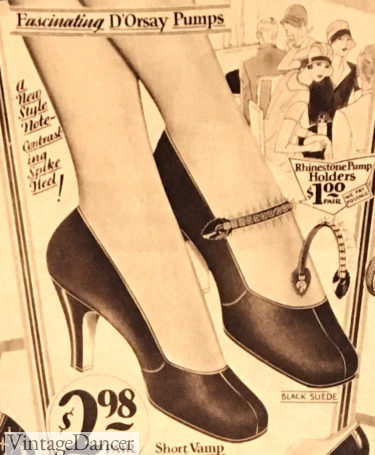
1929 D’Orsay pumps with optional rhinestone holder
- 1921 pump with French heel
- 1927 “Dorothy” pumps
- 1928 classic pumps
T-Strap Heels
The most iconic strappy shoe was the Sally Pump, T-Strap, or T-Bar (British). It had ne strap coming from the toe to the vamp, and another going across the vamp to create a “T” shape. This style briefly appeared in the early twenties then came back slowly in the late twenties, followed by an enormous explosion in the 1930s. The T-strap allowed the shoe to stay on snug while also showing off as much skin (errr, stockings) as possible. Women learned they were perfect for a night of dancing.
- 1922 T-Strap heels
- 1924 T-Strap French heel shoes in grey suede
- 1928 patent T strap evening heels
1920s Evening Shoes / Dancing Heels
Women could wear any of the above strappy heels and pumps for a night out. For those extra special evening shoes or dancing shoes, however, women purchased shiny satin pumps. Black or white satin had the most shine, and black patent leather pumps were the most versatile. High-end evening dresses were sold with matching dyed satin shoes which could feature any color found on the dress.
Silver and gold painted pumps and strap heels were also popular at the end of the decade. The height of the heel was raised to almost 3 inches and slimmed down into a “spike” heel.
Many shoe designers hand-painted shoes in swirls of gold, silver, red, and blue inspired by Asian or Greek motifs. Rhinestones, sequins or diamanté were also added to many heels. The more “bling,” the better.
- 1922 satin one strap heels
- 1922 white satin heels
- 1929 silver pumps with rhinestone studded heels
- 1929 D’Orsay pumps with optional rhinestone holder
Casual 1920s Shoes
Not all shoes in the 1920s were fancy heels. Women had a choice of casual shoes for daily wear around the house, running errands, traveling, and playing in summer. At first glance they may look just as formal as heels, but in the ’20s these were considered casual. Heel heights lowered, straps thickened, and colors were more diverse than those on the fancy types.
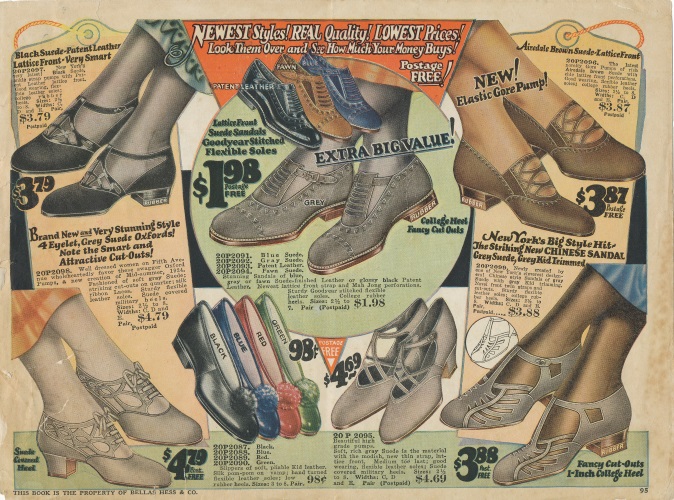
1924 Casual and sporty-style shoes
Oxford Shoes
The sturdy lace-up Oxford shoe was a woman’s everyday shoe of the 1920s. They became even more popular in the 1930s when the trend was for practicality, rather than ornate beauty. The ’20s Oxford was usually plain smooth leather with a cap toe and thick and short 1 to 1 and 3/4 inch military heel. Oxfords laced-up the vamp with 3 -5 eyelets and tied with round cord or flat ribbon ties. Most Oxfords featured the new rubber heel, which made them more comfortable walking shoes.
Higher heels made Oxfords look dressier, especially with pretty ribbon tie laces and contrasting trim. They could be worn with day and afternoon dresses or casual separates.
- 1922 cap toe Oxford
- 1926 semi dressy Oxford
- 1928 two tone fancy Oxford
Low heel, almost flat oxfords, were practical shoes for housework, sports, leisure, or any activity that required a lot of walking or standing. Working women, housewives, the elderly, students, and the very poor turned to these simple shoes for all-day comfort and a lower price tag. Some sports models came with grooves or nubs on the heels for grip on grassy surfaces.
- 1922 basic Oxford
- 1927 cap toe flat Oxford
- 1929 sport Oxfords
The sportiest version of the Oxford shoe was made in two colors such as brown and white, black and white, brown and fawn (tan), or grey and white. In summer, all-white leather could be replaced by all-white canvas with patent leather, suede, or canvas trim. As the decade progressed, the two-toned Oxford became more and more ornate. Instead of blocks of color like the saddle shoe, the dark color trimmed the shoe in swirls all over. Laces also contrasted with the trim.
White summer shoes also came in Mary Jane heels, T-straps, pumps, boots, and low-heel slippers. Some featured cutouts and vents in the toe box. White shoes were almost always worn with white dresses and white tennis outfits. They were tricky to keep clean, and therefore were reserved either for special outfits or worn by the wealthy who had maids to keep them clean.
- 1922 summer white shoes, heels, boots, and Oxfords
- 1922, black and white sporty canvas shoes
One specific pattern of two-tone Oxford shoe was the saddle shoe, although it wasn’t called a saddle shoe until the 1930s. It was a very low heeled, thick-soled, lace up Oxford made of sturdy calfskin leather. The center “saddle” panel was dark, while the toe and heel were white. Brown and white or grey and white were the most trendy colors, but black and white saddle shoes were available too. In the late ’20s, the center dark panel turned into polka dots, plaid, checks, or paisley prints. Small cutouts or brogue patterns on the toe or seams made them even wilder.
Saddle shoes became the required shoe of many school uniforms for both boys and girls. Women liked to wear them, too, with their new sporty golf and tennis clothes. Read more about the evolution of the saddle shoe here.
- 1922 dressy saddle Oxfords
- 1922 square toe saddle Oxford
1920s Tennis Shoes
The tennis shoe or sneaker started to get its place in the 1920s. Flat lace-up canvas shoes with flexible rubber soles such as Keds Champion Classics were popular with women athletes in white, black, and brown canvas. There were also high top canvas sneakers, like Converse All Stars, worn for indoor sports and gym classes. They could be one solid color, or the more popular white with black trim. Women in the 1920s played more sports for leisure, or at least dressed as if they did. A pair of canvas tennis shoes were perfectly fashionable for a picnic in the country.

1927 low and high top canvas sneakers
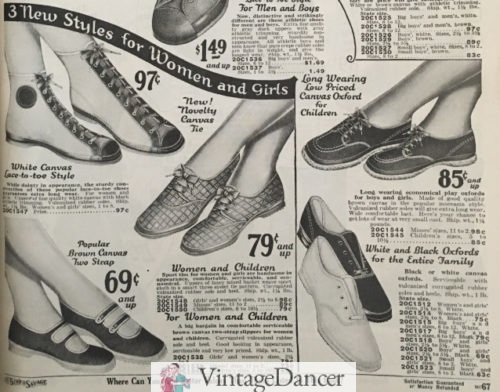
1927 canvas hip tops, woven oxfords, canvas sandals, and low tennis shoes.
Sandals
Flips flops and other iconic sandals were not part of the 1920s. Instead, any type of dressy shoe (Mary Janes, strappy pumps) that featured a lot of cutouts and exposed skin was called a sandal. These summer-only shoes could be made of leather, suede, canvas, or brocade with a leather or rubber sole. The popular Chinese board game Mah Jong turned many shoes into Mah Jong sandals, inspired by Chinese slippers. Dressy sandals were worn with stockings or possibly socks. I have no doubt some women didn’t use either in the midst of a very hot day.
Learn more about the history of vintage sandals here.
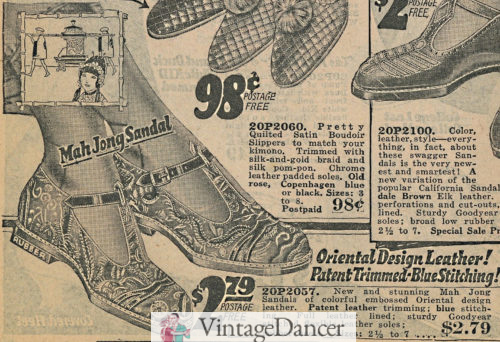
1924 Mah Jong Sandals
- 1920 Sally or T-strap low heel sandals
- 1924 Everyday Sandals
Canvas sandals with rubber soles and canvas lace-up boots were beach shoes, worn with swimsuits and beach pajamas. Brown, black, blue, or white canvas with white piping around the straps was the primary style for most of the decade. Tall socks were worn with beach shoes in the early years, but went out of fashion by the middle years.
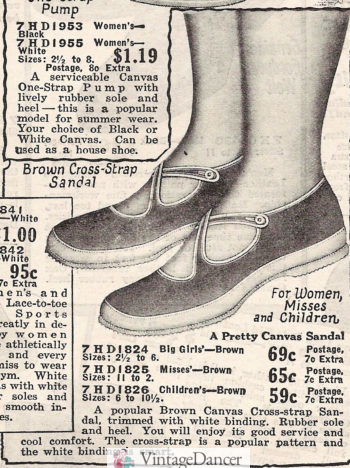
1927 Canvas Beach Sandals
Lace-up Boots
Prior to the 1920s and into the first few years, women mostly wore tall lace-up boots. They were favored by mature women who could not get using to wearing anything else. Walking boots typically had a low heel, pointed or squared cap toe, and hooks with laces that drew up to mid-calf. Although the dressy lace-up boot almost went extinct by 1924, lace-up boots continued to be offered as either a dressy winter boot (lined in wool or shearing) or light hiking boots.
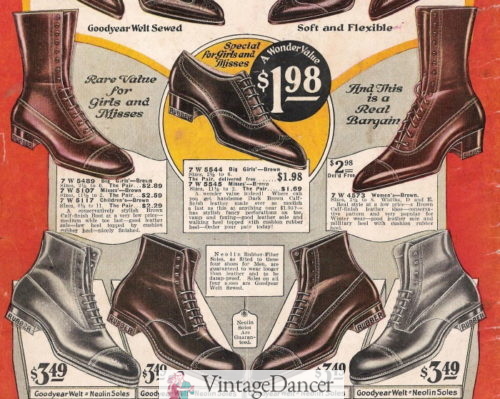
1923 dressy lace-up boots
Also into the early 20s, women continued to wear spats with low heel Oxfords to create a boot look. Spats protected the wearer from the dirt and grime of the city while providing the option to wear flexible low shoes. They came in grey, tan, black, or white. There were also tall leggings made of a jersey that buttoned up the side, similar to spats. These could be any height including over the knee, keeping stockings clean and women’s legs warm in winter.
- 1929 shearling lined winter boots
- 1929 leggings and spats
- 1929 walking or hiking boots
Hiking boots, riding boots, and sporty snow boots worn with breeches laced-up almost to the knee. Many featured a strap around the calf that buckled. The sole was quite thick and grooved for maximum grip.For comparison, lighter hiking boots like the ones above went only above the ankle with full laces. My grandmother was a member of the Sierra Club and she wore boots like these to go hiking. Read more about vintage hiking clothes and boots here.
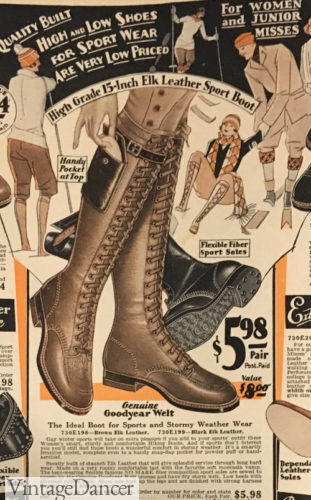
Russian Boots
In the 1920s, boots were practical instead of fashionable, with one exception — the Russian boot. It was a leather mid-calf to knee-high pull-on boot with a straight shaft and a 1-2″ Louis or Cuban heel. The Russian boot fit loose enough over the calf that some bunching around the ankle was expected. Indeed, it was this looseness and flexibility that made them more comfortable than most lace-up leather boots. Introduced in 1921, the Russian boot developed a reputation of being worn by women who frequented speakeasies and other underground establishments. Hiding a flask at the top of the boot gave new meaning to the term “bootlegger.”
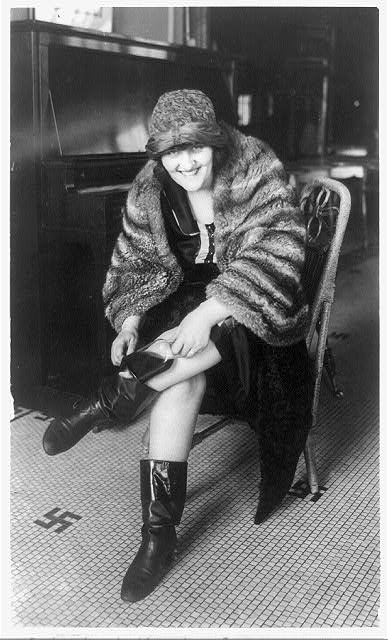
1922, hiding a flask in Russian boots
For the typical women, Russian boots made feet look large under short dresses. Poor quality materials also made them impractical as weatherproof shoes. They never went mainstream because of this. Learn more on the Wiki.
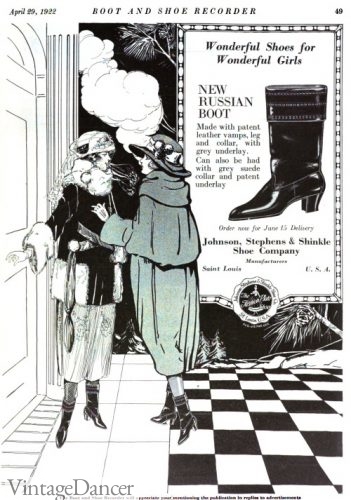
1922 Russian boot ad
Galoshes and Overshoes
Did you ever wonder where the name “flapper” from? One popular theory is from the “flap flap flap” sound that unbuckled galoshes made when teens walked. Galoshes or overshoes were worn over nice walking Oxfords and strappy heels. They had thick rubber bottoms and rubber or felt sides to keep wetness out. The four large buckles across the front were supposed to be buckled over the shoes, but it was simply too much fun to leave them unbuckled and folded over into half-boots.
Galoshes and other winter overshoes were called Artics. The outer body was made of thick wool felt, oiled leather, or rubber. They often were lined in soft and warm cashmere, jersey cloth, thick shearling wool, or fur. Grooved rubber soles were grooved provided tread.
By the end of the decade, the winter boot became more fashionable, with shorter ankle booties that had only one buckle strap or a few side buttons. The top shaft folded up or down revealing the lining. The started to come in more colors and textures to match the fashions on the day. Read more about winter, rain, and snow boots here.
- Tall Rubber bottom boots with lace up leather shaft
- 4 buckle and 1 buckle galoshes
- 1929 overshoes
- 1930 colored overshoes
- 1929 button or zip up overboots
- 1929 tweed buckle overshoes
Slippers
Bedroom slippers, like house dresses and lingerie, were more colorful than day or evening shoes. Made of silk, quilted satin, felt, velvet or soft sheepskin leather, they were just what a woman needed after a full day on her feet. Vivid pink, blue, red, purple, teal, yellow, black or orange in solid or plaid patterns brightened the slippers. Many were fur-lined or rimmed in fur around the edges. They had a tiny heel, softly pointed toe, and often came with a fuzzy pom on top. Some slippers had slightly higher curved heels for a dressier look. Most were slip-on loafers, moccasins, or ankle booties. Read more about slippers and pajamas here.
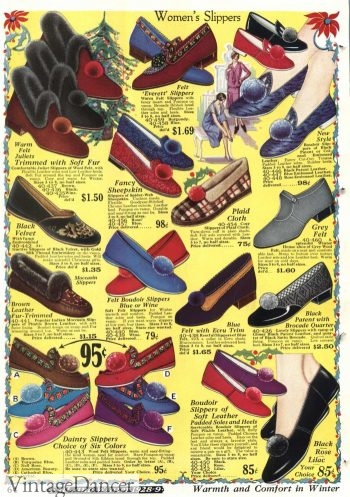
1928 house slippers
1920s Shoes Today
Reproduction shoes – There are just a few small companies that make reproduction historical footwear using modern sizes and materials. They are in the over $200 range and made in limited sizes and widths. Many shoes are paintable or dyeable, so get creative and give them some color.
New 1920s style shoes – Reproduction shoes can still be out of budget for many people or too “costume” looking for everyday shoes. That is where buying new 1920s style shoes makes perfect sense. I keep an eye out for any shoe with a T-strap thin Mary Jane strap in black, white or tan since they match with the most outfits. I also look for low heeled Oxfords with lace-ups and sporty two-tone shoes for casual wear. If you can’t wear a heel, there are many low heel pumps, T-strap or Mary Jane flats, Oxford flats and saddle shoes that would look great with your ’20s outfit. There are shoes for WIDE or narrow feet as well as all leather sole shoes for dancers. UK shoppers can look here and AU shoppers look here for more local shoe options.
Recycled Shoes – For you creative types or broke students, a pair of shoes from your closet or thrift store can be a great start to a pair of 1920s style shoes. Take any T-strap, Mary Jane or simple pump and:
- Paint. Using shoe paints or colorful shoe polish, you can transform your plain shoes into an Art Deco work of art. Look at vintage shoe pictures for inspiration and pick colors that will be bold. No need to match your shoes to your dress. That was a trend that went out of fashion after 1922. Your shoes should coordinate with your accessories — hats, shawl, jewelry, etc.
- Dye. If you have a pair of white satin wedding shoes, chances are the fabric is dyeable. Use RIT fabric dye to change the color, then decorate as you wish.
- Bedazzle. 1920s formal shoes had plenty of sparkling heels, decorative vamps, and pretty buckles. You can buy rhinestones or beads and glue them on, or use peel and stick sparkles for a temporary and quick fix. Sparkle stickers can be found in the scrapbook section of your local craft store. The two black shoes with sparkle rhinestones above used stickers.
- Fabric coverings. I haven’t tried this, but several friends have done it with good success. Use a thin silk or satin fabric and glue to re-cover old shoes. Use binding tape for the seams.
Shop 1920s Style Shoes Here
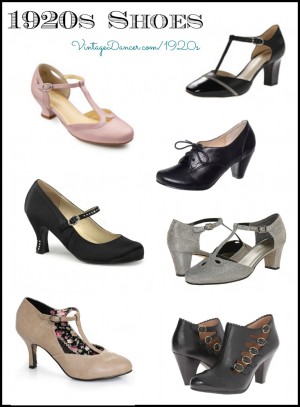
1920s Style Shoes
Debbie Sessions has been teaching fashion history and helping people dress for vintage themed events since 2009. She has turned a hobby into VintageDancer.com with hundreds of well researched articles and hand picked links to vintage inspired clothing online. She aims to make dressing accurately (or not) an affordable option for all. Oh, and she dances too.
